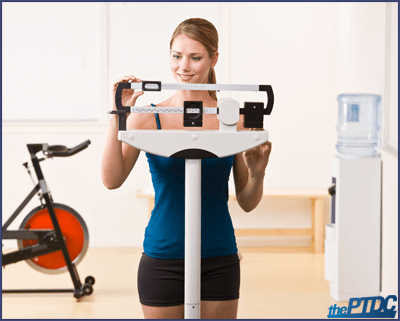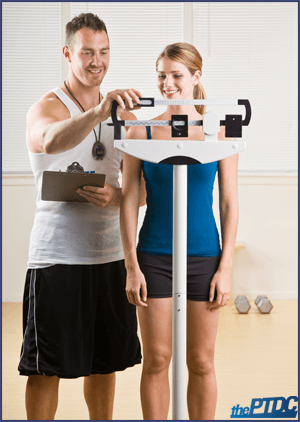Every personal trainer, when learning how to train clients, is taught that they must go through a thorough assessment with their clients. Well, after 18 years in this business, I do far less assessing and far more guessing -- not to be different, but to be efficient.
I've found many similar patterns that exist among individuals, and through the years have developed systems of training that produce "reproducible" results. Where the client fits into these systems depends on their individual needs and goals. Often, assessments can be conducted through the training process, rather than a separate entity on its own. This can save the client time and money and can actually lead to better results.
Editor Note: Coach Jon Goodman and Mike Reinold have already collaborated on a piece discussing whether assessments are relevant to being with. Click the link to read that one after. (personal trainer client assessments)
Not everyone is "numbers-oriented" to begin with. Forcing an assessment on a prospect can be quite disturbing to some. In fact, many gyms do this on purpose to show the potential client how out of shape they are and how much they need personal training. It's a dirty little trick to sell personal training services.
I've found that most sedentary individuals really don't care where they stand compared to others; they just want to get better themselves. Really, the whole practice of assessment leads to neuroticism -- clients concentrate on the outcome rather than the process. Instead, we should encourage clients to focus on self-improvement, or relative results, rather than how they stack up against the norms.

I do think that it is useful to generate a baseline with regard to body composition. Anthropometric measurements should be taken initially, but the extent of these measurements will depend on the individual. I know the second a client walks through my door how I plan to measure him or her. For sedentary individuals, their body mass index (BMI) will dictate the measurements performed as outlined below.
BMI > 30: weight, height, and 6 girth measurements (chest, waist, hip, right arm/thigh/calf), but no skinfolds
BMI = 25-30: weight, height, 6 girth measurements (as above), and 5 skinfold measurements (triceps, biceps, subscapular, suprailiac, calf)
BMI < 25: weight, height, 15 girth measurements (neck, shoulder, chest, right arm/forearm/wrist, left arm/forearm/wrist, waist, hip, right thigh/calf, left thigh/calf), and 13 skinfold measurements (chin, cheek, pectoral, triceps, biceps, subscapular, midaxillary, suprailiac, umbilical, quadriceps, hamstring, knee, calf)
For most athletes and active individuals, the BMI is not a great scale to use. Many of these individuals would be classified as overweight or obese according to the BMI because, as you know, it only reflects quantity not quality of weight per height.
For instance, take the average linebacker in football -- they would be considered obese according to BMI criteria, but most have low single-digit body fat levels. With these individuals, you would perform comprehensive measurements (weight, height, 15 girth and 13 skinfold measurements) and you would do so on a more frequent basis.
Postural Assessment
In the past, I spent quite a bit of time assessing posture - to the point of taking specific measurements to gauge just how far off of "ideal" an individual is. Today, I have a much better method and it takes seconds. It involves a camera and 3 photos of the individual -- front, side and back. Of course, they have to wear as little clothing as possible, but this method serves two purposes:
a) It displays the before and after changes that occur in body composition, and
b) It displays the before and after changes in posture.
For the latter, simply lay a grid pattern over the photos -- this can be done right on your computer with any paint program, or you can print the photos and use a transparent stencil over them. That should give you all the information you need.
This method is far more efficient for both you and the client, and in my opinion, gives you more information in the end. Instead of showing clients a bunch of numbers that they don't understand, you can simply show them the results of their hard work through the photos. A picture is worth a thousand words!
Fitness Testing

Here in Canada a popular method of testing fitness levels involves the Canadian Physical Activity, Fitness & Lifestyle Appraisal (known as the CPAFLA). Let's review some of the tests used in the CPAFLA.
Push-Ups.
First off this is a muscular endurance test, not a true test of strength, and no matter how you try to standardize the test; the reality is that most out-of-shape individuals perform it terribly! A push-away is a much better option that gives you a decent reading of upper body and core strength for the general population. You can use a power cage or Smith machine and start with the bar fairly high. Keep lowering the bar by one notch until the client is unable to perform the exercise with proper form. Record the height and that can be used as a benchmark.
The other reason I'm not such a huge fan of push-ups is that it further encourages poor posture with many people. Why do we often test pushing strength but not pulling strength?
Sit-And-Reach Test.
This test doesn't really tell us anything. If you review the classic text Muscles: Testing & Function by Kendall, McCreary and Provance (1993), you'll notice that many different strategies are used when one tries to touch their toes -- some accomplish the task with flexible backs, others with flexible hamstrings, not to mention limb-length discrepancies that exist among individuals, and so on. You might even encounter a hypermobile client.
Furthermore, there is a low correlation between static and dynamic flexibility. And flexibility is joint specific - we're not testing overall flexibility, and we're not solely testing hip flexibility since the back and other variables come in to play, so what are we truly measuring during the sit-and-reach test?
Step Aerobic Test.
It's interesting how every single person that I've used this test on has improved over time without doing much aerobic work at all. Most have improved just through strength training alone. I'm a big fan of unilateral movements during the initial phases of training to improve left-right symmetry. The step-up is one of those movements, and I believe that it contributes to success on the step aerobic test.
Functional Assessment
Most people present with the following issues: tight hip flexors and weak lower abdominals, rounded shoulders and forward head syndrome, and left-right discrepancies. It's pretty much a given that these exist with the majority of people that request your services. These issues must be addressed in training, assuming of course, that it fits your client's goals.
As I mention in my book The Elite Trainer, you may have an individual with recurring shoulder pain and extremely poor posture approach you with the goal of entering a powerlifting contest in the next few months. You must train them to bench press as much weight as possible, even though it may further compromise shoulder integrity and deteriorate posture!
When it comes down to it, according to Nick Tumminello, "fitness professionals are not really qualified to assess dysfunction nor is that what most people are looking for". Clients use trainers primarily to get in shape and to look better. Clients do not use trainers for assessment - leave that to the physical therapists.
The bottom line is that you can attempt to correct such "dysfunction" through appropriate training, without the need of an assessment. It's safe to assume that most of your new clients will have short, tight hip flexors, pectorals, and anterior deltoids. Well, emphasize the stretched position on exercises such as split squats and lying dumbbell presses, respectively. Then, strengthen the long, weak lower abdominal and posterior deltoid muscles by emphasizing the contracted position on exercises such as pelvic tilts and one-arm elbow-out dumbbell rows, respectively.
The options are endless, but the point remains the same: guess the dysfunction, do not assess the dysfunction. Work within your scope of practice and do what you do best -- train your clients. By constantly monitoring their progress, you can refine the prescription to suit their individual needs.
Other Diagnostics
In the mid 1990s, I was one of the few kinesiologists to begin their career in the fitness sector rather than a rehabilitative setting. When I first decided to become a personal trainer, I had clients take a detailed 7-day dietary log. I entered the data into a Mosby Diet Analysis program that we were taught in school. The software would analyze food intake and energy expenditure, and then spit back a whole bunch of numbers based on dietary reference intakes, recommended nutrient intakes, and the food guide pyramid.
What was the result of this approach? In three words: confusion, regression, and neuroticism. People were more confused than ever. Instead of simplifying the process, these reports were difficult to understand and even more difficult to implement.
Clients were not making the type of progress they deserved for the effort expended, and at times even went backward by gaining some body fat in the process. And finally, trying to control all these variables by measuring food intake and counting calories for every single morsel they ate was not only tedious and inaccurate, but resulted in a neurotic client who couldn't figure out how to follow nutrition advice.
Food allergy testing was the next big thing. You could do some extensive (and expensive) blood work for this purpose, or a less invasive (but still rather expensive) finger prick test. There is much debate over the accuracy and validity of many of these tests, but I won't get into that.
Suffice it to say, most people present with dairy, wheat, and egg intolerances. So rather than testing, why not just remove these foods from the diet altogether for a 6-8 week period, and then gradually reintroduce them back in? This act alone often cures many common complaints, such as bloating, gas, indigestion, acid reflux, throat hoarseness, leaky nose, depressed immunity, and headaches, just to name a few, and it eliminates a persistent stressor -- an insidious source of cortisol that often goes unrecognized.
We all know that cortisol can contribute to fat deposition, particularly android fat (aka "big belly" syndrome), and most people want to reduce the size of their midsection. There's an easy way to accomplish that objective, and no testing is required. Simple advice like "break" the "fast" in the morning, eat 5-6 small meals spread throughout the day at 2.5- to 3-hour intervals, and remove common food triggers. There you go, nothing earth-shattering! You get clients to try that first and see how it goes before considering a diagnostic such as the Adrenal Stress Index panel.
I could go on about other tests as well. We have used numerous blood, saliva, hair, urinary and fecal tests, as well as a zinc tally, DMPS provocation, HCL challenge... you name it, the list goes on -- all are useful, but not mandatory.
When the pieces of the puzzle are not so big and evident, testing may be necessary.
With most clients though, personal training is enough of a commitment that imposing additional time, money and effort into testing is really unnecessary.
Get them started on the path to good health with proper training and eating habits. Of course, if they don't progress as expected, there may indeed be an underlying anomaly that requires attention, and diagnostics are necessary.
In my experience, however, this is more of an exception than a rule. Clients hire you for a reason - train them, don't diagnose them!
References
Kendall, F.P., McCreary, E.K., and Provance, P.G. (1993). Muscles, testing and function (4th ed.). Baltimore, MD: Williams & Wilkins.
McGuff, D., and Little, J. (2009). Body by science: A research-based program for strength training, body building, and complete fitness in 12 minutes a week. New York, NY: McGraw-Hill.
Tumminello, N. (2012). Use this simple knee assessment before you squat or lunge! Retrieved from http://nicktumminello.com/2012/02/use-this-simple-knee-assessment-before-you-squat-or-lunge/










